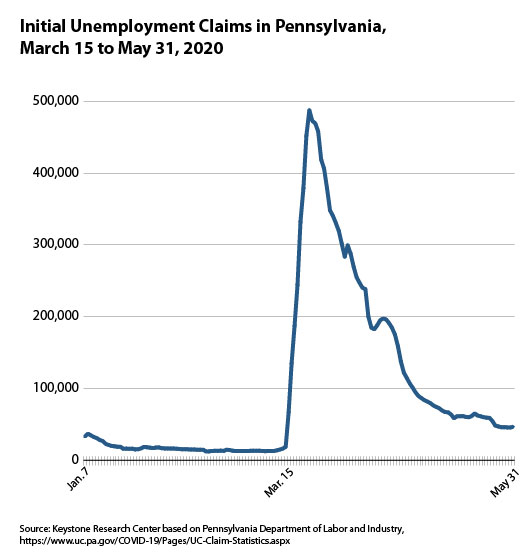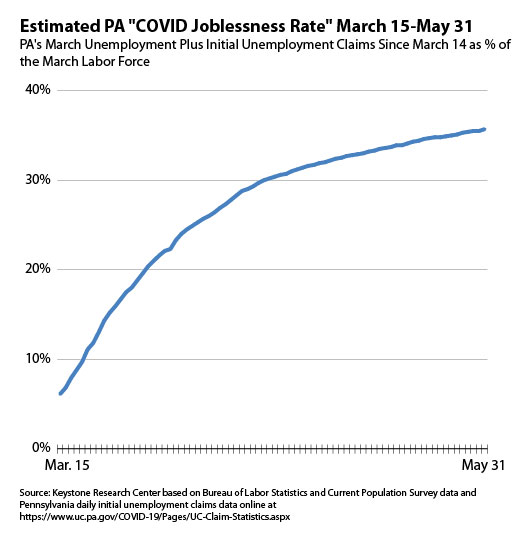This blog provides an update on the impact of the COVID crash on the Pennsylvania economy. The “good news” here is also bad news. Pennsylvania successfully shut down much of its economy to slow the spread of the coronavirus and did so more quickly and fully than most states. If unemployment included everyone who was jobless by May 31 because of COVID, Pennsylvania’s unemployment rate would be roughly twice the official April rate of 15.1%.
Our Depression-era plunge in employment makes it pivotal that federal and state lawmakers (a) provide more resources to families so that they can buy food, pay the rent, access health care, and stay above water while it remains unsafe to fully reignite our economy; and (b) stimulate the economy aggressively as soon as it is safe, avoiding a vicious circle of declining consumer demand, business bankruptcies, high unemployment, and further declines in demand.
The April unemployment and employment rates
On Friday, May 22, the Bureau of Labor Statistics published state employment and unemployment figures for April. Based on data collected April 12-18, Pennsylvania’s official unemployment rate was 15.1% in April. This was above the national unemployment rate of 14.7% and ranked 15th highest of the 50 states. These official unemployment rates underestimate the increase in joblessness because people not looking for work do not count as unemployed—and many people cannot look for work because they are socially isolating at home. (People on temporary layoff, who expect to return to the same job, do count as unemployed.)
Employment numbers capture more fully people who had lost a job as of mid-April. Pennsylvania lost more than one million non-farm jobs from February to April—a decline from 6.038 million to 5.014 million. Pennsylvania employment in April was 17.9% below the February level, the ninth biggest plunge in the nation and well above the national drop of 14%. If all the people who lost jobs between February and April counted as unemployed, the Pennsylvania unemployment rate would have been 23%-24% in April.
Estimating unemployment using initial unemployment claims data through May 25
Our official unemployment rate is above the official April rate for a second reason: that April rate is based on old data collected a month and a half ago. Do we have data on the deterioration in the employment and unemployment situation since mid-April? We do: a daily report of initial unemployment claims posted on the Pennsylvania Department of Labor & Industry website. The chart below displays a 7-day moving total of these initial claims since the start of this year. The chart shows a literally overnight spike in claims from March 15 (roughly 4,000 claims) to March 16 (over 50,000 claims) as Pennsylvania’s lockdown took hold. The chart also shows that initial unemployment claims have remained ten or more times above normal levels since mid-April when April employment and unemployment data were collected.
In total, more than half a million Pennsylvanians have filed initial claims for unemployment since mid-April compared to the 1.4 million that filed from mid-March to mid-April.
Fortune magazine and Voices for Utah Children have used initial unemployment claims data to project joblessness rates at the national level and in Utah. The chart below does the same for Pennsylvania, adding all of the Pennsylvanians filing initial unemployment claims since mid-March (after collection of March unemployment and employment data from March 8-14) to Pennsylvania’s March unemployed population of 6%. This method generates a May 31 joblessness estimate of 35.7%. This estimate likely overestimates joblessness: not every initial unemployment claim since mid-March corresponds to a person still unemployed today. A more realistic joblessness estimate is about 30%. Here are the weeds of this estimate: we know from the official April jobs numbers the correlation between initial claims and the fall in jobs from mid-March to mid-April when job numbers were collected. That correlation allows us to translate the initial claims increase since mid-April into an expected job loss by May 31; that job loss, in turn, gives us our estimate of a joblessness rate of about 30%. In sum, when you take into account the jobless people not counted as unemployed and the fact that the April unemployment figures are based on outdated data, Pennsylvania’s current joblessness rate as of May 31 is about twice the official April unemployment rate of 15.1%.
Policy Implications
The COVID-19 economic decline is having a devastating impact on Pennsylvania workers. While the virus requires us to keep much of the economy in the freezer, individuals, families, states, and small businesses need more economic relief. Once it is safe for people to go back to work, federal and state policy must hit the accelerator even more strongly than in the Great Depression. Our federal and state governments should plan now for a massive investment in infrastructure and public job creation, including revitalizing the Civilian Conservation Corps. U.S. unemployment was 14% or higher in every year from 1931 to 1940. We do not want the current economic wreckage to last nine years. The need for an unprecedented economic stimulus also provides an opportunity to aggressively invest in reducing carbon emissions—a threat to all of us in 2020 just as Nazism was in 1940.

